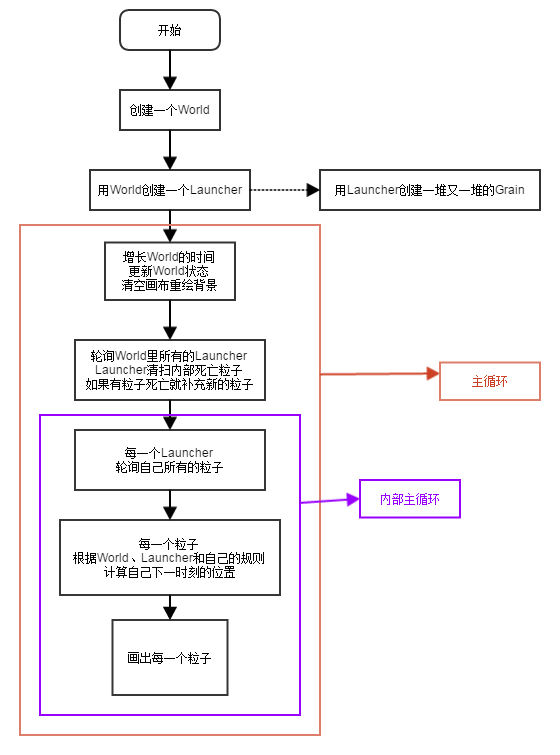【騰訊Bugly干貨】canvas粒子引擎手把手教學,教你驚艷領導和用戶
前言
好吧,說是“粒子引擎”還是大言不慚而標題黨了,離真正的粒子引擎還有點遠。廢話少說,先看[demo],掃描后點擊屏幕有驚喜哦...
本文將教會你做一個簡單的canvas粒子制造器(下稱引擎)。
世界觀
這個簡單的引擎里需要有三種元素:世界(World)、發射器(Launcher)、粒子(Grain)。總得來說就是:發射器存在于世界之中,發射器制造粒子,世界和發射器都會影響粒子的狀態,每個粒子在經過世界和發射器的影響之后,計算出下一刻的位置,把自己畫出來。
世界(World)
所謂“世界”,就是全局影響那些存在于這這個“世界”的粒子的環境。一個粒子如果選擇存在于這個“世界”里,那么這個粒子將會受到這個“世界”的影響。
發射器(Launcher)
用來發射粒子的單位。他們能控制粒子生成的粒子的各種屬性。作為粒子們的爹媽,發射器能夠控制粒子的出生屬性:出生的位置、出生的大小、壽命、是否受到“World”的影響、是否受到"Launcher"本身的影響等等……
除此之外,發射器本身還要把自己生出來的已經死去的粒子清掃掉。
粒子(Grain)
最小基本單位,就是每一個騷動的個體。每一個個體都擁有自己的位置、大小、壽命、是否受到同名度的影響等屬性,這樣才能在canvas上每時每刻準確描繪出他們的形態。
粒子繪制主邏輯
上面就是粒子繪制的主要邏輯。
我們先來看看世界需要什么。
創造一個世界
不知道為什么我理所當然得會想到世界應該有重力加速度。但是光有重力加速度不能表現出很多花樣,于是這里我給他增加了另外兩種影響因素:熱氣和風。重力加速度和熱氣他們的方向是垂直的,風影響方向是水平的,有了這三個東西,我們就能讓粒子動得很風騷了。
一些狀態(比如粒子的存亡)的維護需要有時間標志,那么我們把時間也加入到世界里吧,這樣方便后期做時間暫停、逆流的效果。
- define(function(require, exports, module) {
- var Util = require('./Util');
- var Launcher = require('./Launcher');
- /**
- * 世界構造函數
- * @param config
- * backgroundImage 背景圖片
- * canvas canvas引用
- * context canvas的context
- *
- * time 世界時間
- *
- * gravity 重力加速度
- *
- * heat 熱力
- * heatEnable 熱力開關
- * minHeat 隨機最小熱力
- * maxHeat 隨機最大熱力
- *
- * wind 風力
- * windEnable 風力開關
- * minWind 隨機最小風力
- * maxWind 隨機最大風力
- *
- * timeProgress 時間進步單位,用于控制時間速度
- * launchers 屬于這個世界的發射器隊列
- * @constructor
- */
- function World(config){
- //太長了,略去細節
- }
- World.prototype.updateStatus = function(){};
- World.prototype.timeTick = function(){};
- World.prototype.createLauncher = function(config){};
- World.prototype.drawBackground = function(){};
- module.exports = World;
- });
大家都知道,畫動畫就是不斷得重畫,所以我們需要暴露出一個方法,提供給外部循環調用:
- /**
- * 循環觸發函數
- * 在滿足條件的時候觸發
- * 比如RequestAnimationFrame回調,或者setTimeout回調之后循環觸發的
- * 用于維持World的生命
- */
- World.prototype.timeTick = function(){
- //更新世界各種狀態
- this.updateStatus();
- this.context.clearRect(0,0,this.canvas.width,this.canvas.height);
- this.drawBackground();
- //觸發所有發射器的循環調用函數
- for(var i = 0;i<this.launchers.length;i++){
- this.launchers[i].updateLauncherStatus();
- this.launchers[i].createGrain(1);
- this.launchers[i].paintGrain();
- }
- };
這個 timeTick 方法在外部循環調用時,每次都做著這幾件事:
- 更新世界狀態
- 清空畫布重新繪制背景
- 輪詢全世界所有發射器,并更新它們的狀態,創建新的粒子,繪制粒子
那么,世界的狀態到底有哪些要更新?
顯然,每一次都要讓時間往前增加一點是容易想到的。其次,為了讓粒子盡可能動得風騷,我們讓風和熱力的狀態都保持不穩定——每一陣風和每一陣熱浪,都是你意識不到的~
- World.prototype.updateStatus = function(){
- this.time+=this.timeProgress;
- this.wind = Util.randomFloat(this.minWind,this.maxWind);
- this.heat = Util.randomFloat(this.minHeat,this.maxHeat);
- };
世界造出來了,我們還得讓世界能造粒子發射器呀,要不然怎么造粒子呢~
- World.prototype.createLauncher = function(config){
- var _launcher = new Launcher(config);
- this.launchers.push(_launcher);
- };
好了,做為上帝,我們已經把世界打造得差不多了,接下來就是捏造各種各樣的生靈了。
捏出第一個生物:發射器
發射器是世界上的第一種生物,依靠發射器才能繁衍出千奇百怪的粒子。那么發射器需要具備什么特征呢?
首先,它是屬于哪個世界的得搞清楚(因為這個世界可能不止一個世界)。
其次,就是發射器本身的狀態:位置、自身體系內的風力、熱力,可以說:發射器就是一個世界里的小世界。
最后就是描述一下他的“基因”了,發射器的基因會影響到他們的后代(粒子)。我們賦予發射器越多的“基因”,那么他們的后代就會有更多的生物特征。具體看下面的良心注釋代碼吧~
- define(function (require, exports, module) {
- var Util = require('./Util');
- var Grain = require('./Grain');
- /**
- * 發射器構造函數
- * @param config
- * id 身份標識用于后續可視化編輯器的維護
- * world 這個launcher的宿主
- *
- * grainImage 粒子圖片
- * grainList 粒子隊列
- * grainLife 產生的粒子的生命
- * grainLifeRange 粒子生命波動范圍
- * maxAliveCount 最大存活粒子數量
- *
- * x 發射器位置x
- * y 發射器位置y
- * rangeX 發射器位置x波動范圍
- * rangeY 發射器位置y波動范圍
- *
- * sizeX 粒子橫向大小
- * sizeY 粒子縱向大小
- * sizeRange 粒子大小波動范圍
- *
- * mass 粒子質量(暫時沒什么用)
- * massRange 粒子質量波動范圍
- *
- * heat 發射器自身體系的熱氣
- * heatEnable 發射器自身體系的熱氣生效開關
- * minHeat 隨機熱氣最小值
- * maxHeat 隨機熱氣最小值
- *
- * wind 發射器自身體系的風力
- * windEnable 發射器自身體系的風力生效開關
- * minWind 隨機風力最小值
- * maxWind 隨機風力最小值
- *
- * grainInfluencedByWorldWind 粒子受到世界風力影響開關
- * grainInfluencedByWorldHeat 粒子受到世界熱氣影響開關
- * grainInfluencedByWorldGravity 粒子受到世界重力影響開關
- *
- * grainInfluencedByLauncherWind 粒子受到發射器風力影響開關
- * grainInfluencedByLauncherHeat 粒子受到發射器熱氣影響開關
- *
- * @constructor
- */
- function Launcher(config) {
- //太長了,略去細節
- }
- Launcher.prototype.updateLauncherStatus = function () {};
- Launcher.prototype.swipeDeadGrain = function (grain_id) {};
- Launcher.prototype.createGrain = function (count) {};
- Launcher.prototype.paintGrain = function () {};
- module.exports = Launcher;
- });
發射器要負責生孩子啊,怎么生呢:
- Launcher.prototype.createGrain = function (count) {
- if (count + this.grainList.length <= this.maxAliveCount) {
- //新建了count個加上舊的還沒達到最大數額限制
- } else if (this.grainList.length >= this.maxAliveCount &&
- count + this.grainList.length > this.maxAliveCount) {
- //光是舊的粒子數量還沒能達到最大限制
- //新建了count個加上舊的超過了最大數額限制
- count = this.maxAliveCount - this.grainList.length;
- } else {
- count = 0;
- }
- for (var i = 0; i < count; i++) {
- var _rd = Util.randomFloat(0, Math.PI * 2);
- var _grain = new Grain({/*粒子配置*/});
- this.grainList.push(_grain);
- }
- };
生完孩子,孩子死掉了還得打掃……(好悲傷,怪內存不夠用咯)
- Launcher.prototype.swipeDeadGrain = function (grain_id) {
- for (var i = 0; i < this.grainList.length; i++) {
- if (grain_id == this.grainList[i].id) {
- thisthis.grainList = this.grainList.remove(i);//remove是自己定義的一個Array方法
- this.createGrain(1);
- break;
- }
- }
- };
生完孩子,還得把孩子放出來玩:
- Launcher.prototype.paintGrain = function () {
- for (var i = 0; i < this.grainList.length; i++) {
- this.grainList[i].paint();
- }
- };
自己的內部小世界也不要忘了維護呀~(跟外面的大世界差不多)
- Launcher.prototype.updateLauncherStatus = function () {
- if (this.grainInfluencedByLauncherWind) {
- this.wind = Util.randomFloat(this.minWind, this.maxWind);
- }
- if(this.grainInfluencedByLauncherHeat){
- this.heat = Util.randomFloat(this.minHeat, this.maxHeat);
- }
- };
好了,至此,我們完成了世界上第一種生物的打造,接下來就是他們的后代了(呼呼,上帝好累)
子子孫孫,無窮盡也
出來吧,小的們,你們才是世界的主角!
作為世界的主角,粒子們擁有各種自身的狀態:位置、速度、大小、壽命長度、出生時間當然必不可少
- define(function (require, exports, module) {
- var Util = require('./Util');
- /**
- * 粒子構造函數
- * @param config
- * id 唯一標識
- * world 世界宿主
- * launcher 發射器宿主
- *
- * x 位置x
- * y 位置y
- * vx 水平速度
- * vy 垂直速度
- *
- * sizeX 橫向大小
- * sizeY 縱向大小
- *
- * mass 質量
- * life 生命長度
- * birthTime 出生時間
- *
- * color_r
- * color_g
- * color_b
- * alpha 透明度
- * initAlpha 初始化時的透明度
- *
- * influencedByWorldWind
- * influencedByWorldHeat
- * influencedByWorldGravity
- * influencedByLauncherWind
- * influencedByLauncherHeat
- *
- * @constructor
- */
- function Grain(config) {
- //太長了,略去細節
- }
- Grain.prototype.isDead = function () {};
- Grain.prototype.calculate = function () {};
- Grain.prototype.paint = function () {};
- module.exports = Grain;
- });
粒子們需要知道自己的下一刻是怎樣子的,這樣才能把自己在世界展現出來。對于運動狀態,當然都是初中物理的知識了:-)
- Grain.prototype.calculate = function () {
- //計算位置
- if (this.influencedByWorldGravity) {
- this.vy += this.world.gravity+Util.randomFloat(0,0.3*this.world.gravity);
- }
- if (this.influencedByWorldHeat && this.world.heatEnable) {
- this.vy -= this.world.heat+Util.randomFloat(0,0.3*this.world.heat);
- }
- if (this.influencedByLauncherHeat && this.launcher.heatEnable) {
- this.vy -= this.launcher.heat+Util.randomFloat(0,0.3*this.launcher.heat);
- }
- if (this.influencedByWorldWind && this.world.windEnable) {
- this.vx += this.world.wind+Util.randomFloat(0,0.3*this.world.wind);
- }
- if (this.influencedByLauncherWind && this.launcher.windEnable) {
- this.vx += this.launcher.wind+Util.randomFloat(0,0.3*this.launcher.wind);
- }
- this.y += this.vy;
- this.x += this.vx;
- thisthis.alpha = this.initAlpha * (1 - (this.world.time - this.birthTime) / this.life);
- //TODO 計算顏色 和 其他
- };
粒子們怎么知道自己死了沒?
- Grain.prototype.isDead = function () {
- return Math.abs(this.world.time - this.birthTime)>this.life;
- };
粒子們又該以怎樣的姿態把自己展現出來?
- Grain.prototype.paint = function () {
- if (this.isDead()) {
- this.launcher.swipeDeadGrain(this.id);
- } else {
- this.calculate();
- this.world.context.save();
- this.world.context.globalCompositeOperation = 'lighter';
- thisthis.world.context.globalAlpha = this.alpha;
- this.world.context.drawImage(this.launcher.grainImage, this.x-(this.sizeX)/2, this.y-(this.sizeY)/2, this.sizeX, this.sizeY);
- this.world.context.restore();
- }
- };
嗟乎。
后續
后續希望能夠通過這個雛形,進行擴展,再造一個可視化編輯器供大家使用。
對了,代碼都在這:https://github.com/jation/CanvasGrain





































